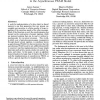Free Online Productivity Tools
i2Speak
i2Symbol
i2OCR
iTex2Img
iWeb2Print
iWeb2Shot
i2Type
iPdf2Split
iPdf2Merge
i2Bopomofo
i2Arabic
i2Style
i2Image
i2PDF
iLatex2Rtf
Sci2ools
95
Voted
SPAA
1990
ACM
1990
ACM
Wait-Free Data Structures in the Asynchronous PRAM Model
A wad-free implementation of a data object in shared memory is one that guarantees that any process can complete any operation in a finite number of steps, regardless of the execution speeds of the other processes. Much of the literature on wait-free synchronization has focused on the construction of atomic registers, which are memory locations that can be read 01 written instantaneously by concurrent processes. This model, in which a set of asynchronous processes communicate through shared atomic registers, is sometimes known as asynchronous PRAM. It is known, however, that the asynchronous PRAM model is not sufficiently powerful to construct wait-free implementations of many simple data types such as lists, queues, stacks, test-and-set registers, and others. In this paper, we give an algebraic characterization of a large class of objects that do have wait-free implementations in asynchronous PRAM, as well as a general algorithm for implementing them.
Asynchronous Pram | Asynchronous Pram Model | Atomic Registers | Distributed And Parallel Computing | SPAA 1990 |
Related Content
| Added | 11 Aug 2010 |
| Updated | 11 Aug 2010 |
| Type | Conference |
| Year | 1990 |
| Where | SPAA |
| Authors | James Aspnes, Maurice Herlihy |
Comments (0)

